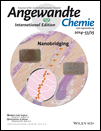Synthesis of Poly(ethylene oxide) Approaching Monodispersity†
P.G.B. thanks the EPSRC for financial support.
Graphical Abstract
Counting mers: Poly(ethylene oxide) (PEO) is one of the most widely used polymers, but polydispersity hinders establishing its structure–property relationships. A synthetic procedure that provides PEO with an unprecedented low level of dispersity is reported. In addition a mass spectrometric method is presented to measure such low dispersity.
Abstract
Polydispersity in polymers hinders fundamental understanding of their structure–property relationships and prevents them from being used in fields like medicine, where polydispersity affects biological activity. The polydispersity of relatively short-chain poly(ethylene oxide) [(CH2CH2O2)n; PEO] affects its biological activity, for example, the toxicity and efficacy of PEOylated drugs. As a result, there have been intensive efforts to reduce the dispersity as much as possible (truly monodispersed materials are not possible). Here we report a synthetic procedure that leads to an unprecedented low level of dispersity. We also show for the first time that it is possible to discriminate between PEOs differing in only 1 ethylene oxide (EO) unit, essential in order to verify the exceptionally low levels of dispersity achieved here. It is anticipated that the synthesis of poly(ethylene oxide) approaching monodispersity will be of value in many fields where the applications are sensitive to the distribution of molar mass.





